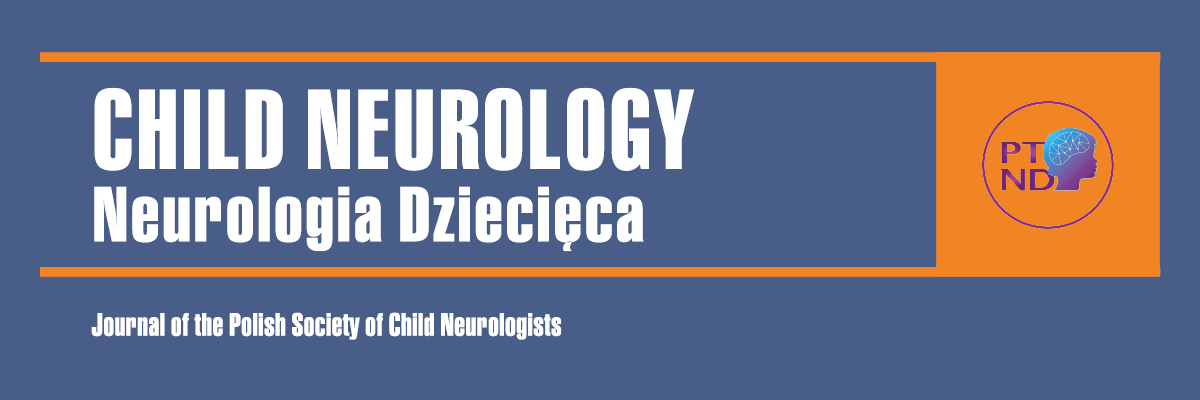Vol 34, No 62 (2024): Continuous Publishing
Case report
Published online: 2024-11-06
Progressive epileptic encephalopathy due to mutations in the HSD17B gene — bifunctional enzyme deficiency. A case report
DOI: 10.5603/cn.99865
Neurol Dziec 2024;34(62):11-17.
Abstract
Peroxisomal diseases result from genetically determined abnormal production of peroxisomes or a deficiency of a single peroxisomal enzyme. They are characterized by a wide, partially overlapping spectrum of symptoms, and in standard clinical assessment their molecular basis is impossible to differentiate.
The most severe form of peroxisome biogenesis disorders is Zellweger syndrome, associated with a characteristic phenotype and key symptoms: hypotension, the onset of seizures at 1 month of life, neurodevelopmental delay, and increased VLCFA concentration in the serum. A similar clinical picture is observed in bifunctional protein deficiency, hence it is sometimes called pseudo-Zellweger syndrome.
The following paper presents a case of a patient with a bifunctional enzyme deficiency.
There is no causal treatment for peroxisomal diseases and treatment is only supportive and symptomatic.
Keywords: peroxisomal diseasesbifunctional enzyme deficiencyZellweger syndrome spectrumVLCFAvery long chain fatty acids
References
- Zschocke J, Hoffmann G. Vademecum Metabolicum. Milupa Gmbh, Friedrichsdorf 2004.
- Stradomska TJ. Peroxisomal disorders. Postepy Biochem. 2018; 64(4): 359–367.
- Möller G, van Grunsven EG, Wanders RJ, et al. Molecular basis of D-bifunctional protein deficiency. Mol Cell Endocrinol. 2001; 171(1-2): 61–70.
- Orpha.net. Zaburzenia biogenezy peroksysomów, spektrum zespołu Zellwegera. https://www.orpha.net/pdfs/data/patho/PL/ZaburzeniabiogenezyperoksysomuspektrumzespoluZellwegera-PLplAbs11215.pdf.
- Klouwer FCC, Berendse K, Ferdinandusse S, et al. Zellweger spectrum disorders: clinical overview and management approach. Orphanet J Rare Dis. 2015; 10: 151.
- Steinberg SJ, Raymond GV, Braverman NE, et al. Zellweger Spectrum Disorder. GeneReviews® [Internet].
- Braverman NE, D'Agostino MD, Maclean GE. Peroxisome biogenesis disorders: Biological, clinical and pathophysiological perspectives. Dev Disabil Res Rev. 2013; 17(3): 187–196.
- Lee PR, Raymond GV. Child neurology: Zellweger syndrome. Neurology. 2013; 80(20): e207–e210.
- Ferdinandusse S, Denis S, Mooyer PAW, et al. Clinical and biochemical spectrum of D-bifunctional protein deficiency. Ann Neurol. 2006; 59(1): 92–104.
- Landau YE, Heimer G, Barel O, et al. Four patients with D-bifunctional protein (DBP) deficiency: expanding the phenotypic spectrum of a highly variable disease. Mol Genet Metab Rep. 2020; 25: 100631.
- Amor DJ, Marsh APL, Storey E, et al. Heterozygous mutations in cause juvenile peroxisomal D-bifunctional protein deficiency. Neurol Genet. 2016; 2(6): e114.
- Nascimento J, Mota C, Lacerda L, et al. D-bifunctional protein deficiency: a cause of neonatal onset seizures and hypotonia. Pediatr Neurol. 2015; 52(5): 539–543.
- McMillan HJ, Worthylake T, Schwartzentruber J, et al. Specific combination of compound heterozygous mutations in 17β-hydroxysteroid dehydrogenase type 4 (HSD17B4) defines a new subtype of D-bifunctional protein deficiency. Orphanet Journal of Rare Diseases. 2012; 7(1).
- Grønborg S, Krätzner R, Spiegler J, et al. Typical cMRI pattern as diagnostic clue for D-bifunctional protein deficiency without apparent biochemical abnormalities in plasma. Am J Med Genet A. 2010; 152A(11): 2845–2849.
- Wanders RJA, Waterham HR. Peroxisomal disorders: The single peroxisomal enzyme deficiencies. Biochim Biophys Acta. 2006; 1763(12): 1707–1720.
- Braverman NE, Raymond GV, Rizzo WB, et al. Peroxisome biogenesis disorders in the Zellweger spectrum: An overview of current diagnosis, clinical manifestations, and treatment guidelines. Mol Genet Metab. 2016; 117(3): 313–321.
- Werner KM, Cox AJ, Qian E, et al. D-bifunctional protein deficiency caused by splicing variants in a neonate with severe peroxisomal dysfunction and persistent hypoglycemia. Am J Med Genet A. 2022; 188(1): 357–363.
- Heubi JE, Bove KE, Setchell KDR. Oral cholic acid is efficacious and well tolerated in patients with bile acid synthesis and Zellweger spectrum disorders. J Pediatr Gastroenterol Nutr. 2017; 65(3): 321–326.
- Berendse K, Klouwer FCC, Koot BGP, et al. Cholic acid therapy in Zellweger spectrum disorders. J Inherit Metab Dis. 2016; 39(6): 859–868.





